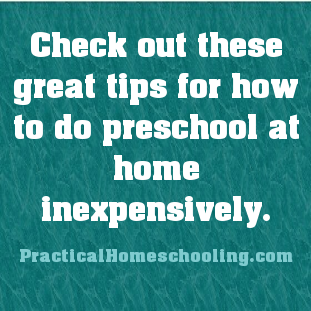 The local school down the block spends large sums of money buying great educational toys, games, books, tot-sized furniture, perfect storage, and beautiful decor. How can you possibly compete?
The local school down the block spends large sums of money buying great educational toys, games, books, tot-sized furniture, perfect storage, and beautiful decor. How can you possibly compete?
You don't need to. Give your child the most important element - you. Everything else is extra.
That said, you can have a lot of fun with the right stuff for your family.
Let's start with the basics.
Portable Learning Materials
Foster independence with lightweight storage, desks, chairs and tables. Young children love to be with you, so portable furniture makes it easy to move from place to place. For quiet learning times, wigglers may need snuggly bean bags; sedentary children get moving with tot-sized rocking chairs or exercise balls. Small plastic outdoor tables work great as easy to carry desks for tots. Old plastic tablecloths or shower curtains cover the floor for messy crafts.
Sturdy boxes and crates make storage easy for books and games. Various sizes of food storage containers, dish pans or old refrigerator bins work well for storage, as well as for indoor/outdoor sand, bean or water play. Make extra wide shelves out of boards to store your boxes.
Field Trip Notions
Check thrift stores for inexpensive, sturdy backpacks or luggage for field trips. A big or high-energy kid needs to carry a heavier pack than a small or frail child.
Keep an eye out for lunch boxes or zippered cloth bags for your child's portable art or science kit. Include items such as stencils, crayons, paper, markers, magnifier, and bug jar.
Some of the best learning can take place in the car. Stash lap boards, trays or covered cake carriers (look for a flat top for a drawing surface, and store art supplies in the cake pan) under the seat. Hang cloth bags over the back seat of your car. Use the bags for storing learning materials or corralling trash from craft projects.
Bargain Hunting
Take your child with you to library book sales, dollar stores, thrift stores and "back to school sales." Your child can pick out inexpensive consumable items such as small paper pads, chalk boards, play dough, and magnetic writing boards with attached styluses. Check garage sales for fun learning tools such as puzzles, wipe-off books, large building bricks, an echo microphone for music and language development, coloring books (for tracing, not coloring), large paper pads, blunt scissors made for small hands, erasers and pencil grips, alphabet/number blocks, large magnets or magnetic toys, magnetic letters and numbers, sturdy, giant piece puzzles. I've often found high quality educational materials for bargain prices at upscale neighborhood garage sales.
Play is important for young learners. Dolls or stuffed animals with clothes need to be fed, tied, zipped, buttoned, etc. If potty training needs to be part of your homeschool, look for a "drink and wet" doll. Find new looking dolls at thrift stores - usually missing clothing. A friend or sibling's discarded baby clothes, cloth diapers and old bottles will sometimes fit a large baby doll.
"I Made It Myself!"
Use your imagination. Make a treasure storage box for books out of cardboard or wood. Whip up your own no-cook play dough recipes - try ingredients such as peanut butter, oatmeal, flour, salt, warm water, and drink powder. Discover washable edible finger paint (add food color to whipped cream or pudding). Stamp out letters and numbers from gelatin (use less water, so gelatin is very thick) or form cookie dough shapes with cookie cutters. Collect discarded items to make coffee can drums, soda bottle flutes, peanut butter jar bug houses, and paper plate shakers. Create homemade puzzles (glue pictures to cardboard and cut in large, simple shapes). Search for more ideas on the Internet with keywords, such as "kid crafts."
Use bold, dark marker on a paper pad or old wallpaper book to write down your child's stories. Let your child draw pictures to illustrate the book, or cut them out of a magazine. Have your child write "The Story of Me." Include child's name, birthday, age, address, phone number, siblings, pets, grandparents, favorite toys, games, and interests.
When Clutter Multiplies
We've never had a big preschool/elementary budget (usually $50 or less). However, our problem has not been having too little - it has been having too much. My bumper sticker should warn, "Brakes for all garage sales." Stuff just seems to come to me - and who can resist if it only costs a quarter at a garage sale?
It helps to rotate. Put some things up in a closet for a few months. Later, get them out for a special occasion such as a long car trip or for a sitter to use on parent's date night.
Enjoy setting up your homeschool on a shoestring. You can create the perfect place for you and your child to hug, learn and have fun together!